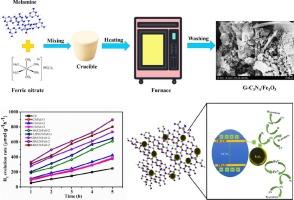Enhancing photocatalytic efficiency and hydrogen production through oxygen-defective g-C3N4/Fe2O3 composites
IF 5.1
3区 材料科学
Q2 MATERIALS SCIENCE, COATINGS & FILMS
引用次数: 0
Abstract
Photocatalytic hydrogen production and organic pollutant degradation offer promising solutions to global energy and environmental challenges. In this work, we report a facile thermal pyrolysis synthesis of an oxygen-deficient g-C₃N₄/Fe₂O₃ (CN/FeO) composite, which exhibits superior photocatalytic performance. The optimized CN/FeO-2 sample achieved 89.9 % degradation efficiency for crystal violet (CV) dye and a hydrogen evolution rate of 423 μmol g−1 h−1, which are 1.4 and 2.92 times higher than pristine g-C₃N₄, respectively. The enhanced activity is attributed to improved visible-light absorption, increased surface area, and efficient charge separation induced by oxygen vacancies. Further enhancement was realized by Pt loading, yielding a 6.2-fold increase in H₂ production. Structural, optical, and electrochemical analyses—including PL, EIS, and EPR—confirmed reduced electron-hole recombination and enhanced interfacial charge transfer. The composite also demonstrated good stability and recyclability, making it a promising candidate for solar-driven photocatalytic applications.

氧缺陷g-C3N4/Fe2O3复合材料提高光催化效率和产氢率
光催化制氢和有机污染物降解为全球能源和环境挑战提供了有希望的解决方案。在这项工作中,我们报道了一种简单的热裂解合成了缺氧g-C₃N₄/Fe₂O₃(CN/FeO)复合材料,该复合材料具有优异的光催化性能。优化后的CN/FeO-2样品对结晶紫(CV)染料的降解效率为89.9%,析氢率为423 μmol g−1 h−1,分别是原始g- c₃N₄的1.4倍和2.92倍。活性的增强归因于可见光吸收的改善,表面积的增加以及氧空位诱导的有效电荷分离。通过Pt负载实现了进一步的增强,使H₂产量增加了6.2倍。结构、光学和电化学分析(包括PL、EIS和epr)证实了电子空穴复合的减少和界面电荷转移的增强。该复合材料还表现出良好的稳定性和可回收性,使其成为太阳能驱动光催化应用的有希望的候选者。
本文章由计算机程序翻译,如有差异,请以英文原文为准。
求助全文
约1分钟内获得全文
求助全文
来源期刊

Diamond and Related Materials
工程技术-材料科学:综合
CiteScore
6.00
自引率
14.60%
发文量
702
审稿时长
2.1 months
期刊介绍:
DRM is a leading international journal that publishes new fundamental and applied research on all forms of diamond, the integration of diamond with other advanced materials and development of technologies exploiting diamond. The synthesis, characterization and processing of single crystal diamond, polycrystalline films, nanodiamond powders and heterostructures with other advanced materials are encouraged topics for technical and review articles. In addition to diamond, the journal publishes manuscripts on the synthesis, characterization and application of other related materials including diamond-like carbons, carbon nanotubes, graphene, and boron and carbon nitrides. Articles are sought on the chemical functionalization of diamond and related materials as well as their use in electrochemistry, energy storage and conversion, chemical and biological sensing, imaging, thermal management, photonic and quantum applications, electron emission and electronic devices.
The International Conference on Diamond and Carbon Materials has evolved into the largest and most well attended forum in the field of diamond, providing a forum to showcase the latest results in the science and technology of diamond and other carbon materials such as carbon nanotubes, graphene, and diamond-like carbon. Run annually in association with Diamond and Related Materials the conference provides junior and established researchers the opportunity to exchange the latest results ranging from fundamental physical and chemical concepts to applied research focusing on the next generation carbon-based devices.
 求助内容:
求助内容: 应助结果提醒方式:
应助结果提醒方式:


